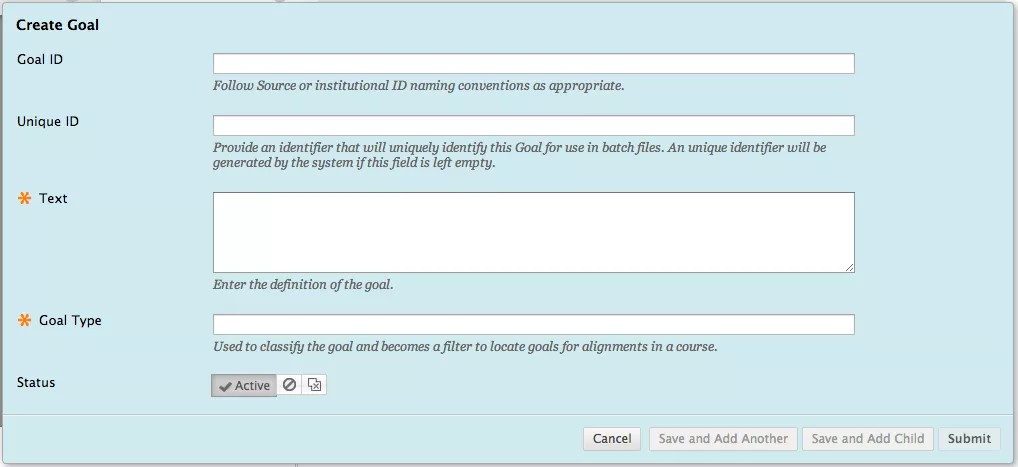Goals in Outcomes Assessment
Outcomes assessment provides a platform for managing assessment of your institution's curriculum and programs.
Your institution's assessment process can consist of three steps:
State the future outcomes expected
Collect data to report on the success or failure of the outcomes
Reflect on ways to achieve more successful results in the future
Expected outcomes may include formal academic accreditation processes, budget projections, and evidence for creating new degree programs. Expected outcomes are benchmarked or measured against different goals in different contexts.
You can give expected outcomes different names based on historical conventions and measure them in different ways. Blackboard already provides a flexible goals interface that enables you to organize and label goals in a way that best meets your needs. With the addition of outcomes assessment, you can define relationships between goals so that the broader context of goals across your institution can be understood.
Given the hierarchical structure of an institution, goals set at a given level of your institution may play a part in the successful attainment of another business unit's goals. Your institution is able to report on goals as they relate to other goals. For example, analyzing how all departments are helping to attain the university's goals or how a course is linked to its department goals. These nested and interrelated goals open a new level of sophisticated reporting that can assess how different facets of an institution are meeting their goals in relation to the institution as a whole.
Internal and external goals
Outcomes assessment goals can come from external or internal sources.
External goals are set by an organization outside your institution that your institution is measured against. External goals, also referred to as standards, can come from these sources:
Federal government
Regional accreditation bodies such as the Southern Association of Colleges and Schools (SACS) or the New England Association of Colleges and Schools (NEASC)
State licensing boards
Government agencies
Professional organizations
Internal goals are set by your institution and its constituent departments to gauge student learning as a means to measure academic program viability, institutional effectiveness, and demonstrate accountability to internal and external stakeholders.
The role of goals in assessment
Goals, also known as outcomes, learning statements, objectives, and standards, identify an end result and expectations established by internal and/or external stakeholders. Goals identify the institution or program expectation of student ability upon completion of a course, program (major and/or degree), and graduation. Goal statements start as broad statements, often addressing competencies such as critical thinking, quantitative analysis, or scientific literacy. Goals are often required to become more specific to meet the needs of an academic program or major, using discipline-specific language to articulate specialized expectations.
Goals across your institution don't need to relate to one another. However, demonstrating how goals among programs relate to institutional goals can illustrate a coherence in curricular objectives across the continuum of learning.
For further detail and examples, see one of the many texts on this concept: Assessment Clear and Simple: A Practical Guide for Institutions, Departments, and General Education by Barbara E. Walvoord.
Classify goals in Blackboard
The organization of goals in Blackboard is designed to fit the specific nomenclature unique to each institution. Goals are organized by sets, categories, parent goals, and child goals.
Goal Sets: Represent the collection goals for a particular unit within an institution
Categories: Represent the subsequent collection of goals within the set
Parent Goals: Broad goal statements
Child Goals: Supportive and detailed statements supporting specific requirements to meet the broader parent goal
For example, an academic unit might organize goals in a collection specific to that unit within your institution. Each subsequent category may then be specific to the related programs of study or departments within your institution, including goals for courses.

Populate and create goals
Populating goals in Blackboard is flexible to meet any organizational process. You can import goals from a locally-created XML template file, downloaded from Anthology Global Support (login required) or manually populated through the goals management interface.
When you create sets, your institution can utilize any organizational language when entering language for goal types. In addition to goal sets and categories, you can use goal types to organize and categorize goals within Blackboard.

You don't need to use a prescribed language to categorize goal types. Types are specific and unique to institutions and units within the institutions per their assessment and operational philosophies. This list includes some suggested types:
Academic Goal
Accreditation Goal
Administrative Goal
Course Goal
Course Outcomes
General Education Outcomes
Goal
Outcomes
Learning Objective
Learning Outcome
Standard
Student Learning Outcome
You can add other descriptors to further define the type, such as undergraduate, graduate, masters, or graduation.